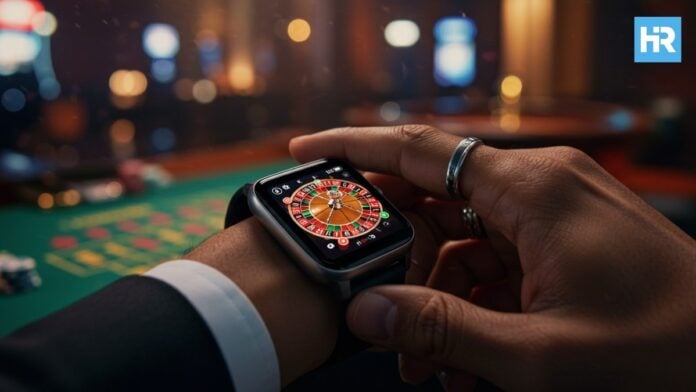Gambling has never been this easy, or this close. What used to require a trip to the casino, or at least pulling out your phone, now fits right on your wrist. Smartwatches, once sold as fitness trackers or productivity tools, are quietly becoming the next frontier for online betting.
And if any place is likely to lead the way, it’s New Jersey, America’s testing ground for gambling innovation.
But this shift isn’t just about new tech. It’s about how – and when – we gamble. Placing a bet mid-jog? Checking odds while grabbing your morning coffee? That’s no longer a fantasy.
The real question isn’t can we do it, but should we? As convenience blurs into habit, and habit tips into risk, we have to ask: are our rules, our devices, and even our instincts ready for what comes next?
A New Player Enters the Game – Smartwatches
Gambling, once the domain of casino floors and desktop screens, has steadily crept into our phones, and now it’s eying our wrists. The rise of gambling on smartwatches is no longer a quirky tech experiment; it’s becoming a serious point of interest for operators and developers alike.
Let’s look at the numbers. According to some research, about one in five U.S. adults now uses a smartwatch or fitness tracker regularly. Pair that with recent data showing that 30% of online gamblers in the U.S. rely exclusively on mobile devices, and you begin to see the shape of a new gambling landscape – one driven by immediacy, portability, and, increasingly, discretion.
What’s fueling this shift is more than just user behavior; it’s market momentum. A smartwatch isn’t just another device; it’s always on, always with you, and just subtle enough to let you place a wager mid-meeting without anyone batting an eye.
Still, adoption is cautious. While some platforms have introduced basic smartwatch features (think: cashing out bets or checking live odds), full-on gambling on smartwatches remains limited. No spinning roulette wheels on your wrist, yet. What we’re seeing instead is a slow, strategic rollout: minimal features, quiet testing, and a close eye on user feedback.
Playing Casino Games with Smartwatches – How Does It Work?
Let’s not pretend we’re already living in a James Bond future: New Jersey smartwatch betting isn’t mainstream just yet. But the first signs are here.
From subtle push notifications to tap-and-go cashouts, wearable tech is slowly threading its way into the betting world. It’s not flashy; it’s not even particularly robust. But it’s happening – let’s take a look at how.
What You Can Actually Do (and What You Can’t)
At the moment, smartwatch gambling is like getting the appetizer before the main course. Most apps that have ventured into the space let you check odds, get alerts, and occasionally cash out a bet with a flick of the wrist.
But when it comes to placing a new live bet, browsing markets, or funding your account, you’ll be redirected right back to your phone. According to PlayUSA, these limitations aren’t due to a lack of interest but rather the constraints of current tech and regulatory caution, especially in places like New Jersey.
The Frictionless Fantasy
For bettors in a rush (or in a crowd), this is the dream. No unlocking your phone, no fumbling through apps. You’re watching the Jets lose a 10-point lead, your watch buzzes, and bam, cash out before disaster strikes.
That’s the promise of wearable tech gambling: speed without noise. In the hyper-competitive space of in-play wagers, shaving seconds off the process can be the difference between a smart move and a regret.
Biggest Limitations
Let’s not overhype it. The screen is tiny. The battery doesn’t last all day. The interface is minimal by necessity. A smartwatch might nudge you toward action, but if you want depth, strategy, or even just a second look, you’re grabbing your phone.
Here’s the secret: these apps aren’t trying to replicate the full casino experience – not yet. Instead, they function more like a nudge machine. A line moves, a bet opens, and a game turns. Your wrist buzzes, you react. It’s less about navigation and more about reaction, which is ideal for seasoned gamblers who already know what they’re tracking.
The Road Ahead (and the Wrists Watching)
We’re at the beginning of something, not the end. Voice-activated bets, biometric security checks, even predictive analytics tailored to your betting history, all of that is on the horizon. But for now, wearable tech gambling is still in sandbox mode: small, experimental, and watched closely by regulators.
In New Jersey, where innovation often meets resistance, the expansion of smartwatch betting will depend as much on legal clarity as on tech capability. Betting from the wrist might feel small, but what are its implications? Anything but.
New Jersey and the Legal Framework: Is There Room for Innovation?
New Jersey has built its reputation as a gambling pioneer, first with Atlantic City, then with online poker, and more recently, with mobile sports betting that reshaped the industry nationwide. But with the rise of wearables, a new question is emerging: Is gambling legal on smartwatches in NJ? The short answer is one’s really sure. And that uncertainty might be the most interesting part of the story.
The state’s current regulations, overseen by the Division of Gaming Enforcement, are solid when it comes to phones and tablets. Everything from geolocation to age verification is tightly controlled under the umbrella of “mobile gambling.” But smartwatches? They aren’t directly named.
That leaves operators wondering: Does a tap on the wrist count as a mobile action? Or does it fall into some regulatory gray zone? For a market that thrives on precision, especially in geo-fencing and identity checks, that’s a problem. Or maybe it’s an opportunity.
One of the biggest sticking points is compliance tech. A mobile casino NJ can pinpoint a user’s location with a mix of GPS, Wi-Fi, and mobile network triangulation. Smartwatches, especially those tethered to phones or lacking GPS altogether, aren’t as reliable.
And when it comes to ensuring someone is of legal age or providing tools like self-exclusion, the smartwatch’s tiny interface makes things more complicated. A frictionless experience is great for smartwatch sports betting, but it also risks cutting corners on user protection.
Still, the appetite for innovation is there. Operators are experimenting quietly.
The Appeal of Live Betting on the Wrist
There’s something undeniably tempting about placing a bet without even reaching into your pocket. One glance at your wrist, a quick tap, and you’re in.
For fans of live betting, those mid-game wagers made while the action is unfolding, smartwatches offer something close to the holy grail: speed, subtlety, and instant access. But as with anything in gambling, what feels convenient can just as easily become a slippery slope.
How to Gamble Using a Smartwatch
Here’s how it works: you start by downloading a sportsbook app on your smartphone. That phone app then syncs with your smartwatch, usually an Apple Watch, giving you access to features like odds notifications, bet tracking, and in some cases, one-tap cash-out.
You’re not playing blackjack on your wrist (yet), but you are making decisions that count. It’s less about browsing, more about reacting fast.
Can You Bet from Your Smartwatch in NJ?
Technically, yes; if you’re doing it through a licensed operator and the app verifies you’re physically within New Jersey’s borders.
While state laws don’t explicitly mention smartwatches, the general rule is this: if it’s a mobile device, and it complies with all the usual requirements (age verification, geolocation, account registration), it’s fair game. So, is gambling legal on smartwatches in NJ? There’s no flashing green light, but there’s no red one either.
A Shiny Gadget with Real Stakes
Smartwatches are sleek, efficient, and increasingly part of everyday life. But slap a sportsbook on one, and it becomes something else entirely. It’s not just about tech anymore, it’s about behavior, psychology, and restraint. Operators will need to think hard about how to build responsibly for this format.
While smartwatches promise the future of live betting in miniature, they also magnify its dangers. In the race to innovate, let’s not forget the weight behind that little tap.
Addiction, Discretion, and Dangerous Gamification
At first glance, betting from a smartwatch seems harmless; it’s just a quick glance, a tap, nothing too serious. But that very subtlety is part of the problem. The more invisible gambling becomes, the easier it is to ignore the consequences.
You don’t have to unlock your phone, open an app, or even let anyone around you know what you’re doing. You could be placing a wager during a meeting, at a dinner table, or while pushing your kid on a swing, and no one would notice.
For people in recovery or those managing a gambling problem, this always-on, always-with-you interface introduces a new kind of risk. A smartphone, at least, can be powered off or put away. A watch? It lives on your body. The notifications buzz on your skin.
The temptation is literally pulsing at your wrist. And when you combine that with the rapid pace of live betting, you get a situation that’s almost designed to override impulse control.
Passing Trend or Structural Transformation?
It’s easy to dismiss smartwatch gambling as a novelty, a clever add-on for early adopters and tech junkies.
But that would be missing the forest for the trees. What’s happening on the wrist might be less about the device itself and more about the direction the industry is heading. Betting is becoming frictionless, ambient, and embedded into our daily rhythms.
We’ve already seen the signs elsewhere. In the UK and Australia, gambling platforms have leaned heavily into tech, introducing personalized push alerts, AI-driven odds suggestions, and interfaces designed to feel as natural as checking a message. What begins as convenience quietly turns into habit.
Now, imagine that same model translated to a device that never leaves your body. Add voice commands, biometric logins, and predictive prompts, and you start to see a picture that’s less about a new gadget and more about a structural shift in how and when we place bets.
Of course, this doesn’t mean every bettor will suddenly become a wrist-bound high roller. But it does suggest a future where gambling isn’t just something you do, it’s something that’s always available. Whether you act on that availability is another matter, but the tech is heading there. Smartwatches may not transform the industry overnight, but they’re a signal.
What’s Next for Gambling with Smartwatches?
Smartwatches aren’t just changing how we track steps or check the time, they’re quietly reprogramming how we engage with everything, including gambling. What once required a trip to the casino or at least a few swipes on a phone now takes little more than a glance and a tap.
That shift isn’t just about convenience; it’s about proximity. Betting no longer lives in your pocket; it lives in your body. And that brings with it a new wave of questions that are more behavioral than technical, more ethical than logistical. We’re no longer just talking about a smart mobile casino on your phone; we’re talking about one that’s strapped to your wrist, always on, always watching.
New Jersey, with its track record as a digital gambling pioneer, could easily be the first state to fully embrace this next chapter. But regulation, like tech, needs to keep pace. Because as gambling seeps into our daily routines, nudging us from our wrists as easily as a fitness reminder, the real issue isn’t whether the systems work.
It’s whether we’ve fully thought through what it means to gamble this effortlessly, this invisibly, this often. The innovation is impressive. But the real bet is on what we do with it.






